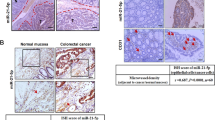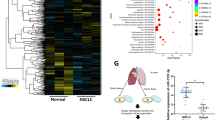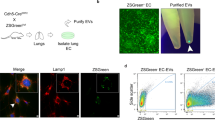Abstract
Recent findings indicate that specific microRNAs (miRNAs), such as those of the miR-17-92 cluster, may be responsible for regulating endothelial gene expression during tumor angiogenesis. Secreted miRNAs enclosed in exosomes also have an important role in cell–cell communication. To elucidate whether miRNAs secreted from neoplastic cells transfer into endothelial cells and are functionally active in the recipient cells, we investigated the effect of exosomal miRNAs derived from leukemia cells (K562) on human umbilical vein endothelial cells (HUVECs). As K562 cells released the miR-17-92 cluster, especially miR-92a, into the extracellular environment, K562 cells, transfected with Cy3-labeled pre-miR-92a, were co-cultured with HUVECs. Cy3-miR-92a derived from K562 cells was detected in the cytoplasm of HUVECs, and the Cy3-miR-92a co-localized with the signals of an exosomal marker, CD63. The expression of integrin α5, a target gene for miR-92a, was significantly reduced in HUVECs by exosomal miR-92a, indicating that exogenous miRNA via exosomal transport can function like endogenous miRNA in HUVECs. The most salient feature of this study is the exosome, derived from K562 cells with enforced miR-92a expression, did not affect the growth of HUVECs but did enhance endothelial cell migration and tube formation. Our results support the idea that exosomal miRNAs have an important role in neoplasia-to-endothelial cell communication.
This is a preview of subscription content, access via your institution
Access options
Subscribe to this journal
Receive 50 print issues and online access
$259.00 per year
only $5.18 per issue
Buy this article
- Purchase on Springer Link
- Instant access to full article PDF
Prices may be subject to local taxes which are calculated during checkout





Similar content being viewed by others

References
Heusschen R, van Gink M, Griffioen AW, Thijssen VL . MicroRNAs in the tumor endothelium: novel controls on the angioregulatory switchboard. Biochim Biophys Acta 2010; 1805: 87–96.
Bartel DP . MicroRNAs: genomics, biogenesis, mechanism, and function. Cell 2004; 116: 281–297.
Anand S, Cheresh DA . MicroRNA-mediated regulation of the angiogenic switch. Curr Opin Hematol 2011; 18: 171–176.
Mendell JT . miRiad roles for the miR-17-92 cluster in development and disease. Cell 2008; 133: 217–222.
Suarez Y, Fernandez-Hernando C, Yu J, Gerber SA, Harrison KD, Pober JS et al. Dicer-dependent endothelial microRNAs are necessary for postnatal angiogenesis. Proc Natl Acad Sci USA 2008; 105: 14082–14087.
Kosaka N, Iguchi H, Yoshioka Y, Takeshita F, Matsuki Y, Ochiya T . Secretory mechanisms and intercellular transfer of microRNAs in living cells. J Biol Chem 2010; 285: 17442–17452.
Zhang Y, Liu D, Chen X, Li J, Li L, Bian Z et al. Secreted monocytic miR-150 enhances targeted endothelial cell migration. Mol Cell 2010; 39: 133–144.
Ohyashiki JH, Umezu T, Kobayashi C, Hamamura RS, Tanaka M, Kuroda M et al. Impact on cell to plasma ratio of miR-92a in patients with acute leukemia: in vivo assessment of cell to plasma ratio of miR-92a. BMC Res Notes 2010; 3: 347.
Kosaka N, Iguchi H, Yoshioka Y, Hagiwara K, Takeshita F, Ochiya T . Competitive interactions of cancer cells and normal cells via secretory microRNAs. J Biol Chem 2012; 287: 1397–1405.
Olive V, Jiang I, He L . mir-17-92, a cluster of miRNAs in the midst of the cancer network. Int J Biochem Cell Biol 2010; 42: 1348–1354.
Otsuka M, Zheng M, Hayashi M, Lee JD, Yoshino O, Lin S et al. Impaired microRNA processing causes corpus luteum insufficiency and infertility in mice. J Clin Invest 2008; 118: 1944–1954.
Dews M, Homayouni A, Yu D, Murphy D, Sevignani C, Wentzel E et al. Augmentation of tumor angiogenesis by a Myc-activated microRNA cluster. Nat Genet 2006; 38: 1060–1065.
Bonauer A, Carmona G, Iwasaki M, Mione M, Koyanagi M, Fischer A et al. MicroRNA-92a controls angiogenesis and functional recovery of ischemic tissues in mice. Science 2009; 324: 1710–1713.
Kuehbacher A, Urbich C, Zeiher AM, Dimmeler S . Role of Dicer and Drosha for endothelial microRNA expression and angiogenesis. Circ Res 2007; 101: 59–68.
Iguchi H, Kosaka N, Ochiya T . Secretory microRNAs as a versatile communication tool. Commun Integr Biol 2010; 3: 478–481.
Urbich C, Kuehbacher A, Dimmeler S . Role of microRNAs in vascular diseases, inflammation, and angiogenesis. Cardiovasc Res 2008; 79: 581–588.
Cabrera CV . Lateral inhibition and cell fate during neurogenesis in Drosophila: the interactions between scute, Notch and Delta. Development 1990; 110: 733–742.
Lewis J . Notch signalling and the control of cell fate choices in vertebrates. Semin Cell Dev Biol 1998; 9: 583–589.
Aufderheide E, Chiquet-Ehrismann R, Ekblom P . Epithelial-mesenchymal interactions in the developing kidney lead to expression of tenascin in the mesenchyme. J Cell Biol 1987; 105: 599–608.
Kishimoto Y, Lee KH, Zon L, Hammerschmidt M, Schulte-Merker S . The molecular nature of zebrafish swirl: BMP2 function is essential during early dorsoventral patterning. Development 1997; 124: 4457–4466.
Ebara S, Nakayama K . Mechanism for the action of bone morphogenetic proteins and regulation of their activity. Spine (Phila Pa 1976) 2002; 27: S10–S15.
Chen AL, Fang C, Liu C, Leslie MP, Chang E, Di Cesare PE . Expression of bone morphogenetic proteins, receptors, and tissue inhibitors in human fetal, adult, and osteoarthritic articular cartilage. J Orthop Res 2004; 22: 1188–1192.
Scott WJ, Schreiner CM, Goetz JA, Robbins D, Bell SM . Cadmium-induced postaxial forelimb ectrodactyly: association with altered sonic hedgehog signaling. Reprod Toxicol 2005; 19: 479–485.
Arroyo JD, Chevillet JR, Kroh EM, Ruf IK, Pritchard CC, Gibson DF et al. Argonaute2 complexes carry a population of circulating microRNAs independent of vesicles in human plasma. Proc Natl Acad Sci USA 2011; 108: 5003–5008.
Turchinovich A, Weiz L, Langheinz A, Burwinkel B . Characterization of extracellular circulating microRNA. Nucleic Acids Res 2011; 39: 7223–7233.
Acknowledgements
We thank Dr Shinobu Ueda for processing of miRNA microarray analysis.
This work was supported by the Private University Strategic Research-Based Support Project: Epigenetics Research Project Aimed at General Cancer Cure Using Epigenetic Targets from MEXT (Ministry of Education, Culture, Sports, Science and Technology), Tokyo, Japan.
Author information
Authors and Affiliations
Corresponding author
Ethics declarations
Competing interests
The authors declare no conflict of interest.
Additional information
Supplementary Information accompanies the paper on the Oncogene website
Rights and permissions
About this article
Cite this article
Umezu, T., Ohyashiki, K., Kuroda, M. et al. Leukemia cell to endothelial cell communication via exosomal miRNAs. Oncogene 32, 2747–2755 (2013). https://doi.org/10.1038/onc.2012.295
Received:
Revised:
Accepted:
Published:
Issue Date:
DOI: https://doi.org/10.1038/onc.2012.295
Keywords
This article is cited by
-
Emerging role of exosomes in hematological malignancies
Clinical and Experimental Medicine (2022)
-
SRSF1 regulates exosome microRNA enrichment in human cancer cells
Cell Communication and Signaling (2020)
-
Exosomal miRNAs in hepatitis B virus related liver disease: a new hope for biomarker
Gut Pathogens (2020)
-
Delivery of LNA-antimiR-142-3p by Mesenchymal Stem Cells-Derived Exosomes to Breast Cancer Stem Cells Reduces Tumorigenicity
Stem Cell Reviews and Reports (2020)
-
Tumor-derived exosomes promote angiogenesis via adenosine A2B receptor signaling
Angiogenesis (2020)


